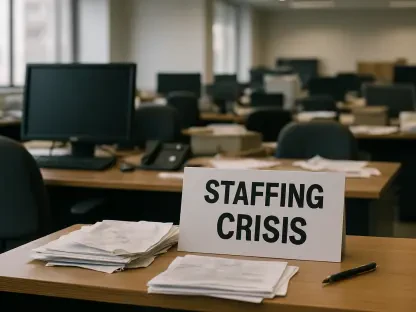The gender pension gap remains a pressing concern in 2025, with a staggering $113,000 disparity between men and women at retirement, driven largely by career breaks often tied to childcare responsibilities. This financial divide not only threatens women’s long-term security but also reflects deeper societal and workplace inequalities. This roundup gathers insights, strategies, and perspectives from various industry voices, including pension providers, HR professionals, and workplace consultants, to explore the root causes of this gap, its broader impacts, and actionable solutions for employers and policymakers. By synthesizing diverse opinions, the aim is to shed light on how this issue can be tackled effectively.
Unpacking the Disparity in Retirement Savings
The gender pension gap has widened to a significant $113,000, with women holding a median pension pot of $173,000 compared to $286,000 for men. Reports highlight that career interruptions, particularly for childcare, play a central role in this imbalance, as women are far more likely to pause their careers. This roundup seeks to dive into the systemic and personal factors fueling this divide while presenting a spectrum of expert-driven ideas for change.
Beyond the numbers, the urgency of addressing this gap lies in its impact on financial stability and workplace equity. Industry leaders emphasize that without intervention, women face heightened risks of poverty in retirement, with many falling below minimum lifestyle thresholds. The discussion ahead will navigate through causes, generational trends, and practical steps to narrow this divide.
This compilation of views also aims to challenge assumptions about individual responsibility versus systemic barriers. By drawing on varied perspectives, the goal is to provide a comprehensive look at how employers, HR teams, and society can collaborate to ensure fairer retirement outcomes for all.
Exploring the Gender Pension Gap: Causes and Consequences
The Burden of Career Interruptions
Career breaks, especially for motherhood, disproportionately impact women, who are statistically 12 times more likely than men to step away from work for family responsibilities. This interruption leads to reduced earnings and stunted pension growth over time. Data reveals a stark contrast in savings, underscoring how these pauses create long-lasting financial setbacks.
HR professionals often point to the concept of a “motherhood penalty,” where women not only lose immediate income but also face slower career progression upon returning to work. This penalty compounds over years, limiting contributions to retirement funds. Such insights highlight the need for targeted support during these critical life stages.
Debate persists over whether personal choices or structural obstacles bear greater blame for this gap. Some argue that societal expectations push women into caregiving roles, while others suggest that individual decisions play a significant role. This tension frames much of the conversation around crafting effective solutions.
Societal Expectations and Domestic Responsibilities
Deep-rooted norms around childcare and household duties continue to place a heavier burden on women, often resulting in diminished earning potential and pension savings. This imbalance slows career advancement and reduces disposable income for retirement planning. The ripple effects are evident in the financial vulnerability many women face later in life.
Statistics show that 36% of women risk retiring below the $13,400 minimum lifestyle threshold, compared to 31% of men, painting a clear picture of inequality. Industry voices stress that perpetuating these norms without reform exacerbates the gap. There is a growing call for cultural shifts to redistribute domestic responsibilities more evenly.
Workplace policies that promote shared parental leave and flexible schedules are often cited as potential game-changers. Advocates argue that normalizing equal responsibility can help mitigate financial disparities. The challenge lies in overcoming entrenched attitudes to implement such changes on a wide scale.
Generational Trends in Seeking Financial Assistance
Younger women, particularly those aged 18-34, demonstrate a heightened awareness of the pension gap, with a significant majority expressing interest in tailored financial support. This contrasts sharply with older demographics, where only about a third of women over 55 show similar enthusiasm. This shift suggests evolving attitudes toward retirement planning.
Regional and demographic differences also shape how women approach pension readiness, with urban and younger cohorts often more proactive. Some industry leaders advocate for early interventions, such as enrolling in schemes at age 18, to build savings momentum. Such measures could capitalize on this emerging awareness among the youth.
Questions remain about whether older generations are truly less receptive to support or if life circumstances influence their priorities. Analysts suggest that targeted education at different life stages could bridge this divide. Understanding these nuances is key to designing inclusive strategies that resonate across age groups.
Emotional and Professional Fallout Beyond Finances
The pension gap extends beyond monetary concerns, affecting women’s confidence in retirement and their career expectations. Many report lower pay aspirations and heightened uncertainty about their future, which can perpetuate cycles of inequality. This emotional toll often goes unaddressed in policy discussions.
Consultants in workplace dynamics note that career breaks can derail professional trajectories, making it harder for women to regain momentum. Educating employees about the long-term consequences of such interruptions is seen as vital. Without this awareness, many may underestimate the impact on their retirement readiness.
Speculation arises about how these unaddressed emotional and career effects might shape future workplace trends. Reduced confidence could lead to lower retention rates or diminished ambition among affected groups. Addressing these intangible impacts is increasingly viewed as essential to holistic solutions.
Strategies for Employers and HR to Close the Gap
The $113,000 pension deficit underscores the urgent need for action, with career breaks, societal norms, and motherhood penalties identified as core contributors. Employers and HR teams are positioned as pivotal players in mitigating this disparity. Diverse industry opinions converge on the importance of proactive, equitable measures to support women’s financial futures.
Solutions include customized communication around life events like childbirth or divorce, ensuring women are informed about pension impacts. Other suggestions involve maintaining contributions during career breaks and offering equal parental leave policies. These steps, often low-cost, are praised for boosting engagement and retention while addressing inequality.
Practical steps for HR include embedding pension discussions into flexible work arrangements and prioritizing clear, trustworthy information over superficial tools. Building a culture of transparency around retirement planning can empower employees to make informed decisions. Such strategies reflect a shared consensus on fostering lasting change through actionable support.
A Push for Systemic Reform and Enduring Fairness
Looking back, the roundup of perspectives revealed a unified concern over the widening gender pension gap, with career breaks emerging as a dominant factor in the $113,000 disparity. Insights from HR experts, pension providers, and consultants painted a multifaceted picture of systemic barriers and personal challenges that fueled this financial divide.
The discussions highlighted innovative approaches, from early pension enrollment to equitable leave policies, as critical steps taken to address the issue. Generational differences in awareness also stood out, with younger women showing greater initiative in seeking support, signaling a shift in mindset that was widely noted.
Moving forward, the focus should shift to dismantling structural inequalities through collaborative efforts among employers, policymakers, and individuals. Exploring further resources on workplace equity and retirement planning can deepen understanding of this complex issue. Committing to sustained policy reform and cultural change remains essential to ensure that no one is left behind in securing a stable retirement.









